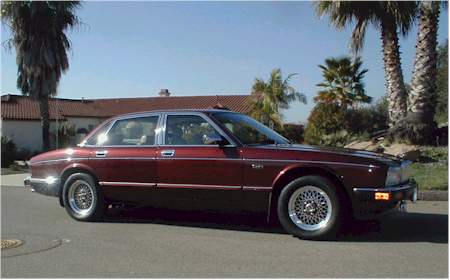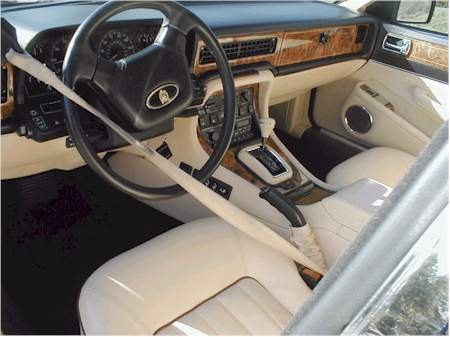|
This is probably the most confusing name because of the Daimler-Chrysler
group and the Mercedes name... so first here is a bit of history courtesy
of Stephen Gibson of Supercat Jaguar Spares.
It
was in 1891 that a British syndicate acquired the Daimler engine patent
rights and the selling rights for the United Kingdom and colonies (except
Canada) of Daimler Motoren Gesellschaft headed by F.R. Simms. It was
not until 1896, a year before the Emancipation Act which first permitted
motoring in Great Britain, that another member of the original syndicate
- Harry J. Lawson floated 'The Daimler Motor Co. Ltd. They made
Gottlieb Daimler honorary president but upon Gottlieb's death in 1900
the German connection was severed forever.
The company set up in a disused cotton mill in Coventry and one of the
early Coventry cars was the first car to travel from John O'Groats to
Lands End. EdwardVII, then the Prince of Wales bought a 6hp Daimler
which marked the begining of a long Royal patronage for the company.
In 1910 the company was absorbed into the profitable Birmingham Small
Arms group (BSA). War time production varied from staff cars, lorries,ambulances,
aero engines, aircraft,tractors, tanks and shells. After the war
in 1919 two 30hp and a special 45hp model was launched. Four wheel brakes
were standardised in 1924 along with thinner sleeve-valves for greater
power. Four special 57hp Daimlers were built for King George V during
1924.
In
1926 Daimler chief engineer Laurence Pomeroy designed the complex sleeve-valve
V12 Double Six, then in 1930 brought out the Fluid Flywheel. In conjunction
with the Wilson preselector gearbox, this hydraulic coupling gave a
simplicity of control unrivalled at the time.
In 1931 the Lanchester company was acquired. Lanchester had built the
first all-British four wheeled car in 1895 and was known for its quality
products which now mirrored the current Daimler range.
Post war austerity was given a slap in the face with what became known
as the 'Docker Years'. Lord and Lady Docker (he was a director of BSA)
had "very special" Daimler models made with the most flambouyant
styles imaginable, some bordering on the edge of bad taste. There is
no denying that the Dockers kept the Daimler name in high profile and
no doubt created great PR for the company.
It was in 1960 that Daimler was taken over by Jaguar who simply needed
manufacturing space to expand but also received the 4.5 litre Majestic
Major engine which was so good that it had to sidelined so as not to
show the XK engine in a bad light. The glassfibre bodied SP250 sports
car designed by Edward Turner carried on for a short while until it
could be decently abandoned and the Turner V8 engine was used in the
Daimler 250 model running alongside the Jaguar MkII. Then the Daimler
as an entity of its own was no more and became the badge engineered
varient of Jaguar Cars Ltd. The Daimler name and pedigree is acknowledged
by being the very best that Jaguar can offer in saloon cars and the
past limousines.
On
the German side... During the 1890s the Austro-Hungarian Consul in Nice,
Emile Jellineck was also the local agent for Daimler cars. He commissioned
batches of cars which he sold to his wealthy acquaintances and was therefore
able to persuade Daimler engineer Wilhelm Maybach to design more powerful
cars. Jellineck ordered a new model as a car of today for tomorrow and
it appeared in 1901 and combined the most modern design features. Jellineck
named this new model Mercedes after his eldest daughter so as to boost
sales in France.
The Daimler company soon adopted the Mercedes name for all their private
cars and development of the original Mercedes 35hp were built under
the name of Mercedes-Simplex. These cars increased in power until the
mighty 9240cc 60hp with overhead inlet valves and 80mph performance
was achieved.
Maybach did not get on with the Daimler management and resigned in 1907
to be replaced by Paul Daimler, son of Gottlieb. The Mercedes marque
dominated the international motor racing scene before the outbreak of
the Great War and was the chosen marque of the Kaiser.
Post war, Paul Daimler carried out supercharging experiments with the
first production supercharged cars appearing in 1921/2. Ferdinand Porsche
became chief engineer in 1923 and introduced a blown overhead camshaft
six cylinder. This was developed further into the Type K (for 'Kompressor')
and produced 110bhp unblown and 160bhp when blown.
By 1926 there was an amalgamation between Mercedes and Benz and the
newly formed group could draw on the technical expertise of a team headed
by Ferdinand Porsche and included Hans Nibel and Fritz Nallinger. All
three were appointed to the board of the new Daimler - Benz company.
The Benz company had been founded by Karl Benz in 1885/6 with a three
wheel motor car and carried on making others which were more popular
in France than Germany. He went on to make four wheeled cars such as
the Benz Viktoria and quite a number of racing cars such as the 1908
Grand Prix Benz which "only" had a 15 litre engine and the
Blitzen Benz of 1909, a 21.5 litre in line four cylinder putting out
200bhp with a maximum speed of 142mph...
Then of course, more recently the Daimler Mercedes Benz group merged
into the Daimler Chrysler group...
|

1990
Majestic : Dave Lockensgard's DAVZCAT
|
There are several
models in the Jaguar family that used theMajestic name, derived from
the upscale Daimler sedans of the '60s. In the U.S., the Vanden
Plas Majestic was sold in 1989, 1990 and 1992 model years only in North
America. As far as production numbers go, these are rough estimates:
1989--> 350
1990--> 527
1992--> 250
The '89 and '92 are obviously round numbers - I would think that the
numbers for '89 are quite a bit too high, since it was introduced late
in the model year. The '92 is also more rare than the '90.
The U.S. VDP Majestic was a High-Trim-Spec Vanden Plas, with the same
113 inch wheelbase as the other XJ40s of its time (this was before the
long-wheelbase (LWB) car was imported into North America). The 89-90
VDP Majestics were identical in trim specification, with the obvious
exceptions being the mechanical differences between the 1989 and 1990
model year cars (3.6->4.0, 4-Round Lights->Composite Lamps, power
hydraulic system driving the brake booster vs. electric pump, ..etc..).
They all have 6-cylinder engines, the XJ12 was never called a Majestic
in the U.S. The VDP Majestic usually included every option available.
All VDP Majestics will say "Vanden Plas" on the left
plaque between the taillights and "Majestic" on the right
plaque, laid out in gold electroplate in a script style with a gold
outline. The '92 models have a Majestic plaque or inscription on the
interior dash wood.
 The car
does not say Jaguar anywhere on the outside except in the bumper strip
along the side, to the rear of the front wheel wells. They came with
special color-matched lambs wool carpets for the passenger and rear
foot wells. The '89 and '90 VDP Majestics were painted Regency Red with
Magnolia interiors finished with Burgundy piping. The 1992s were all
painted Black Cherry (a very dark deep red that looks black except in
direct sunlight) with Creme interiors. The '89 and '90 came with diamond-turned
15" BBS-style lattice rims as often seen on the XJ-S, with the
spaces between the lattice spokes painted body color. The '92
didn't have these wheels. Steering wheels, gearshift knob and gearshift
surround were upholstered in the interior color leather, rather than
the black used in other models. They came with fluted grille surrounds
and boot trim, and instead of the black growler mounted on a rectangular
plate on the top of the grille, VDP Majestics have a round small red
growler badge in this position. Most of the original steering wheels
have been replaced by now with black, since they become extremely dirty
pretty fast. They cost about $55000 - $60000 when new, about $4000
- $5000 more than a Vanden Plas. The car
does not say Jaguar anywhere on the outside except in the bumper strip
along the side, to the rear of the front wheel wells. They came with
special color-matched lambs wool carpets for the passenger and rear
foot wells. The '89 and '90 VDP Majestics were painted Regency Red with
Magnolia interiors finished with Burgundy piping. The 1992s were all
painted Black Cherry (a very dark deep red that looks black except in
direct sunlight) with Creme interiors. The '89 and '90 came with diamond-turned
15" BBS-style lattice rims as often seen on the XJ-S, with the
spaces between the lattice spokes painted body color. The '92
didn't have these wheels. Steering wheels, gearshift knob and gearshift
surround were upholstered in the interior color leather, rather than
the black used in other models. They came with fluted grille surrounds
and boot trim, and instead of the black growler mounted on a rectangular
plate on the top of the grille, VDP Majestics have a round small red
growler badge in this position. Most of the original steering wheels
have been replaced by now with black, since they become extremely dirty
pretty fast. They cost about $55000 - $60000 when new, about $4000
- $5000 more than a Vanden Plas.
There are several other models in the Jaguar family that used the Majestic
name, including the Daimler sedans of the '60s. In 1993 and 1994, a
long-wheelbase XJ40 was produced and was called the Majestic, it served
as a limousine version of the car. As far as I know this was never imported
into North America, but was sold in England, in Europe and in Australia.
When the X300 was introduced to the U.S. market in 1995, a LWB version
was included but was not given the Majestic name. There are several
owners of U.S. VDP Majestics on the XJ40 list.
The
Vanden Plas name originally comes from a dutch coach builder who
designed and built a number of beautiful bodies for such chassis makers
as Bentley in the 20s and 30s. Later on throughout the 60s, the
Vanden Plas name was associated with Daimler, and Roll Royce.
Jaguar
used the name Vanden Plas in 1972 on the V12 Daimler Double Six and
it has been associated with the most luxuriously appointed XJ series
cars ever since. More recently the Vanden Plas badge has been reserved
for US market XJ6s and XJ8s featuring the longer wheel base platform,
flutted grille and boot lid trim, rear picnic tables, veneer inlays
on the dash and doors, and lambswool rugs. Suspensions are tuned for
comfort with different style wheels.
In
2000, Jaguar launched what may consider the ultimate long distance tourer,
the Supercharged Vanden Plas XJ8, combining all of the Vanden Plas luxuries
with the punch of the 370hp blown V8, the same drivetrain found in the
XJR and XKR.
|

